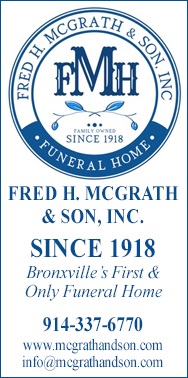Letter to the Editor: Village Historian, Eloise Morgan, Urges Residents to Oppose Paving Yellow Brick Road

Sep. 3, 2014:
To the Editor:
Next Monday night, September 8, Bronxville's board of trustees will vote on a road repair project that threatens the loss of one of the village's historic yellow brick roads. As Bronxville Village historian, I have written the trustees urging them to preserve this important element of our past—both as a matter of historic preservation and of fiscal prudence. I urge Bronxville residents to contact the trustees to express their views as well.
The road at issue is a section of Park Avenue running eastward from Wellington Circle down to Tanglewylde Avenue (in front of 28-33 Park Avenue). Paved with yellow hillside brick nearly 100 years ago, the street has developed an extremely uneven surface exacerbated by chronic water seepage from an unidentified underground source. There is no question that it needs repair.
The brick and granite block roads on the steepest hills in the Lawrence Park Hilltop, which has been designated as a National Historic District, add much to the character and appeal of Bronxville as a community.
We live in a time when historic preservation is an important value, one that the village in recent decades has embraced. Zoning regulations were designed to limit the teardown of older homes. The ornate frames of our street signs are cherished. The antique lanterns and stone pillars on Avon Road were renovated. The almost-90-year-old street clock in Station Plaza has been restored. The 1920s globe street lights of the commercial district continue to beat the odds.
Other cities and towns in the United States, Boston, Nantucket, Charleston, Savannah, Orlando, and Wilmette, Illinois, proudly preserve their brick streets as important elements of their history. Bronxville should do no less.
The Bronxville Historical Conservancy has underscored its commitment to preserving our brick roads by locating suitable antique bricks nearly matching the originals (most of which cannot be salvaged) and by pledging $67,500 to buy them.
Fortunately, this is a situation where the interests of preserving the past and the cost benefits of doing so appear to be aligned. To rebuild this part of Park Avenue and pave it with asphalt will cost about $304,000. To rebuild it with a restored brick roadway will cost an extra $65,000, excluding the cost of brick.
The experience of other communities who value their original brick roads shows that the wise choice financially is to spend more upfront on restoring the brick in exchange for ongoing savings resulting from reduced maintenance. Studies have shown that a properly installed brick road can last for 100 years with substantially lower ongoing maintenance costs than asphalt, which requires frequent maintenance and resurfacing. Financed with bond proceeds, the project cost will be amortized over the life of the bonds.
Although it has often been said that yellow brick roads were built throughout the Lawrence Park Hilltop by William Lawrence in the 1890s, my review of early village board minutes and newspapers shows that most Hilltop roads, like the rest of the village streets, were paved with macadam or forms of asphalt. The more expensive and harder hillside brick was used rarely, and only on some of the steepest slopes, to add traction.
Hillside brick was installed on this section of Park Avenue in 1916 (at the same time a steep hill on Prescott Avenue was bricked). After a hiatus for World War I, the village began paving its streets again in 1922. At that time another stretch of Park Avenue running toward Tanglewylde near the school and the steepest part of Valley Road were paved in brick and Chestnut Avenue was surfaced with granite block. (I have found only two other locations in the village that appear to have been once paved with hillside brick: the railroad underpass on Pondfield Road and a steep section of Tanglewylde Avenue between today's Summit Avenue and Sycamore Street.)
Expenditures for infrastructure projects in the early twentieth century required a village-wide vote. In 1922 the Bronxville president (mayor) urged the passage of several street improvement proposals with an instructive message: "It should be borne in mind by the voters that the improvement of streets in any section of the village adds to the value of all property no matter whether located on these streets or not and careful thought should be given by the property owners in the easterly section of the village before they vote 'No' on a street improvement in the westerly part."
In an age when the value of historic preservation is recognized, one looks back with dismay at the mid-twentieth century's demolition of historic structures such as Penn Station. On a humbler local level, one rues the loss of the Hotel Gramatan, the old village hall building, and many stately nineteenth-century mansions around the village.
If we lose the Bronxville's yellow brick roads to asphalt pavement today, how will we answer the question we ask of the 1950s: What were they thinking?
Please contact the mayor or village trustees and ask them to keep the yellow brick road.
Eloise L. Morgan
Bronxville Village Historian
Editor's note: MyhometownBronxville does not fact-check statements in letters to the editor, and the opinions do not necessarily reflect the thinking of its staff. Its objective in publishing letters to the editor is to give air to diverse thoughts and opinions of residents in the community.
Letters Directory
Bronxville is a quaint village (one square mile) located just 16 miles north of midtown Manhattan (roughly 30 minutes on the train) and has a population of approximately 6,500. It is known as a premier community with an excellent public school (K-12) and easy access to Manhattan. Bronxville offers many amenities including an attractive business district, a hospital (Lawrence Hospital), public paddle and tennis courts, fine dining at local restaurants, two private country clubs and a community library.
While the earliest settlers of Bronxville date back to the first half of the 18th century, the history of the modern suburb of Bronxville began in 1890 when William Van Duzer Lawrence purchased a farm and commissioned the architect, William A. Bates, to design a planned community of houses for well-known artists and professionals that became a thriving art colony. This community, now called Lawrence Park, is listed on the National register of Historic Places and many of the homes still have artists’ studios. A neighborhood association within Lawrence Park called “The Hilltop Association” keeps this heritage alive with art shows and other events for neighbors.
Bronxville offers many charming neighborhoods as well as a variety of living options for residents including single family homes, town houses, cooperatives and condominiums. One of the chief benefits of living in “the village” is that your children can attend the Bronxville School.
The Bronxville postal zone (10708, known as “Bronxville PO”) includes the village of Bronxville as well as the Chester Heights section of Eastchester, parts of Tuckahoe and the Lawrence Park West, Cedar Knolls, Armour Villa and Longvale sections of Yonkers. Many of these areas have their own distinct character. For instance, the Armour Villa section has many historic homes and even has its own newsletter called “The Villa Voice” which reports on neighborhood news.
Village of Bronxville Administrative Offices
337-6500
Open 9:00am - 4pm excluding holidays and weekends
Bronxville Police Department
337-0500
Open 24 hours
Bronxville Parking Violations
337-2024
Open 9:00am - 4pm excluding holidays and weekends
Bronxville Fire Deparment
793-6400







